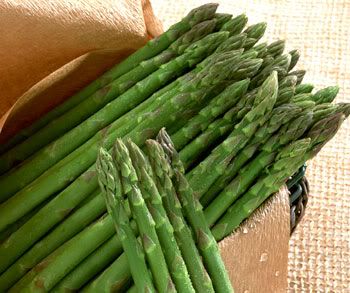Just writing the word “asparagus” makes my mouth water and encourages my heart to beat a little quicker. When I imagine the flavor of asparagus, I’m washed in the feeling of sun-warmth on my back, the smell of wet dirt, and that child-like pleasure of seeing new green life poking through the dark soil. It’s a sweeping reaction to get from a vegetable!
Part of it is just that it’s spring. Finally spring. And I am easily moved by little things like the turn of the seasons. Part of it is that I really love the taste of asparagus. And part of it is that I think we have the potential to react in strong ways to things that have inherently beneficial health benefits. (And yes, maybe I react strongly to french fries as well, but that’s another story.)
So, asparagus. According to the National Cancer Institute, asparagus is the food highest in glutathione, an important anti-carcinogen. It is also rich in two cancer-blocking vitamins (A and C) as well as the mineral selenium. These three nutrients have been singled out in several studies as fierce cancer fighters. A 5.3 ounce serving (only 20 calories!) provides 60 percent of the recommended daily allowance for folacin which is necessary for blood cell formation, growth, and prevention of liver disease. Folacin has been shown to play a significant role in the prevention of neural tube defects, such as spina bifida, that cause paralysis and death in 2,500 babies each year. It is also an excellent source of potassium, fiber, thiamin, vitamin B6, and is one of the richest sources of rutin, a compound which strengthens capillary walls.
Asparagus is harvested from March through June, depending on where you are–early asparagus is pencil-thin and the spears thicken as the season progresses. Most people assume that the thinner the spear, the more tender, but often times tenderness has to do with freshness, not thickness. Your best bet is to buy asparagus that is locally-grown–fresh farmer’s market asparagus practically melts in your mouth! Here in the U.S. we generally eat our asparagus green–white asparagus, popular in Europe, is grown under soil to keep it from becoming green. I believe in the full-range-of-color eating philosophy, so I like mine green. When shopping, look for smooth skin, bright green color, compact heads, and freshly cut ends.
Asparagus is very versatile in terms of cooking; it can be roasted, grilled, steamed, boiled, sauteed, pureed, and eaten raw. I love it in all of its guises. I probably most love it prepared simply, but I will admit that asparagus has a starring role in one of my more decadent food inclinations: roasted skinny spears tossed in truffle oil and sea salt, then topped with a poached egg. (That made me have to take a deep breath and calm myself.) Here are two other great things to do with asparagus:
Simple Roasted Asparagus
2 pounds asparagus, tough ends snapped off
2 tablespoons olive oil
Salt and freshly ground black pepper to taste
1. Preheat oven to 450F. You may either cut the asparagus in 2-inch pieces or leave whole. Drizzle with olive oil, season with salt and pepper, toss gently to coat, and spread in a single layer on a baking sheet.
2. Roast the asparagus until just tender, around 6 to 8 minutes.
Or, make a velvety asparagus soup.





1 comments:
So glad my family enjoys this nutritious vegetable. My son eats them like candy! My daughter only likes the bottoms, weird. The tops are usually what people eat first.
Post a Comment